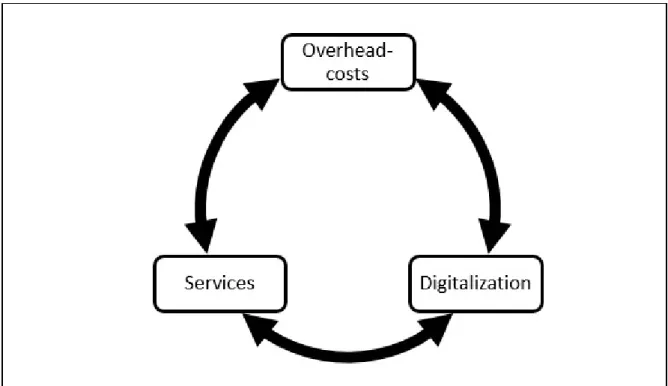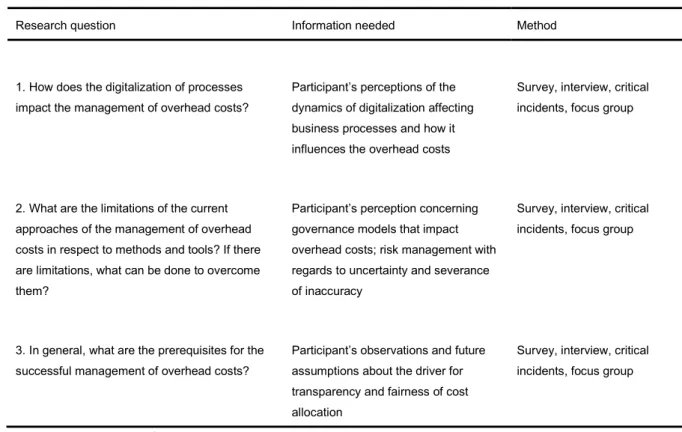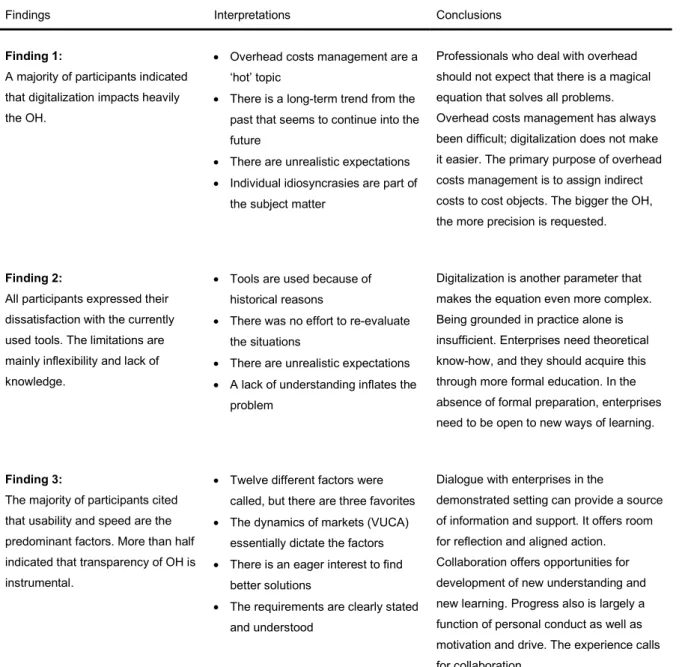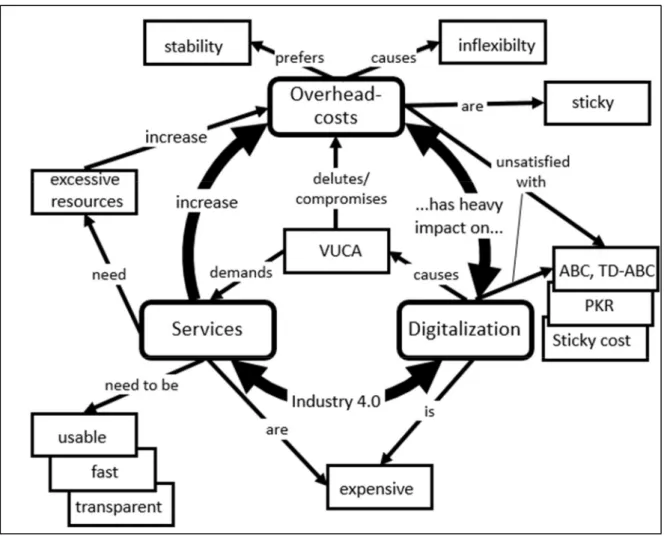Alexandre Lámfalussy Faculty of Economics
István Széchenyi Economics and Management Doctoral School Joint Cross-Border PhD Program
Analysis of Overhead Costs Management in Companies
Doctoral (Ph.D.) Dissertation
Written by:
Dipl.-Ing. Wolfram Irsa, CFPIM, CIRM, CSCP
Supervisor:
Prof. Em. Dr. Székely Csaba, DSc
Sopron 2020
Doctoral school:
Alexandre Lámfalussy Faculty of Economics
István Széchenyi Economics and Management Doctoral School
Topic of the dissertation:
Analysis of Overhead Costs Management in Companies
Head of the doctoral school:
Prof. Dr. Csilla Obádovics, PhD
Supervisor of the dissertation:
Prof. Em. Dr. Székely Csaba, DSc
...
Signature of the supervisor
Table of Contents of the Thesis Booklet
1 Introduction ... 1
2 Explanation of the research topic ... 2
2.1 Research objective ... 2
2.2 Research questions ... 3
2.3 Unit of analysis ... 3
2.4 Hypotheses ... 4
2.5 Research design ... 6
3 Findings and results ... 8
3.1 Evaluation of the hypotheses ... 11
3.2 Answers to the research questions ... 12
3.3 Constraints of the dissertation ... 13
4 New scientific contribution ... 14
5 Summary ... 16
6 Own publications ... 19
1 Introduction
The dissertation seeks to explore the phenomenon of how businesses deal with the increasing importance of overhead-costs management in the advent of innovations driven by digitalization. Digitalization is the process of employing digital information and technologies in order to transform them into business operations. It is the use of digital technologies to change potentially a business model and provide new revenue and value producing opportunities. Conversely, digitization is the process of changing from analog form to digital;
it refers to taking analog information and encoding it into zeroes and ones so that computers can store, process, and transmit information.
The purpose of the dissertation is to explore with a sample of companies their perceptions of and why they believe that overhead costs management is important and how they successfully manage the development of overhead costs, triggered by the innovations of digitalization. It was anticipated that the knowledge generated from this inquiry would create new insights and so inform the academic community and business leaders on the impact of contemporary capabilities. The dissertation employed qualitative multi-case study methodology with quantitative statistical description to portray the phenomenon under investigation. Participants of the dissertation included a purposefully selected group consisting of 20 companies from seven different industries, in Austria, Hungary, and Slovakia; all had an impressive economical track record as world market leaders in their fields. The participants had at least 10 years of experience in the industry, and held management responsibilities; they consisted of seven females and 13 male participants from 27 to 54 years old. The educational level ranged from PhD to technician.
This booklet delivers a condensed summary of the dissertation, which holds 178 pages with appendices. The next chapter explains the research topic, frames the background and the context of the dissertation; it holds the research objective, the research questions, the hypotheses, and the research design. Chapter 3 describes the findings and the results; it evaluates the hypotheses, and answers the research questions. Chapter 4 elaborates on the new scientific contribution; it postulates three theses which are unique in context, region, and time period. Chapter 5 sums up the entire dissertation; it highlights the impact on academia and businesses. Chapter 6 contains the publications that were created in the course of the dissertation.
2 Explanation of the research topic
Cost management has always been important for companies. Since the financial crisis in the year 2008, which turned into an economic crisis for many companies, the successful management of costs became even more important. The overhead costs, which are mostly fixed costs from a structural point of view and indirect costs from an accounting point of view, become more significant due to several reasons. There is the issue of inflexibility of scaling overheads quickly up and down as required in dynamic markets. Further, the reduction of overhead is a delicate process as it often means reducing the headcount. Even if lay-offs can be avoided, the reduction of overhead costs is a significant change which means abandoning well-established routines (e.g. so far unaccounted services need then a precise recording of the service to a sellable cost object).
The continuing surge of overhead is immanent due to the ongoing automation of business processes. Figure 1 shows an increase of overhead from 50% in the middle of the 19th century to roughly 85% 190 years later as a percentage of value added. The data stem from the North American Manufacturing Futures Survey and used as a research method a survey with more than 200 respondents from just as many different business units; the typical job description of the respondents was vice president of operations. The survey was repeated in the subsequent years with respondents from Asia and Europe, which supported the original results.
The scientific value of the survey appears questionable as there is ambiguity within the understanding of the term overhead over such a long period of time. Nevertheless, the survey and the publication disclosed for the first time the long-term dynamics of the topic and stimulated awareness for systematic research. As of now, the trend indicates that overhead will still continue to slightly rise. Consequently, the direct labor will decrease. The dissertation seeks to bolster the understanding of the survey with qualitative and quantitative research methods.
2.1 Research objective
Research indicates that a compelling number of businesses are wondering how the changing environment caused by digitalization in the last years will impact their capability to successfully manage overhead costs. Hence, despite their fortunate past and their serious investment of time and money to understand upcoming innovations, these businesses face uncertainty concerning their future existence. In fact, uncertainty is just one element of four, which are known as VUCA. VUCA stands for volatility, uncertainty, complexity, ambiguity
and describes the dynamics in digitalized markets. There is little information about how to successfully handle this phenomenon.
2.2 Research questions
The purpose of the dissertation was to explore with 20 businesses their perceptions of how they manage overhead costs in the advent of business processes digitalization. It is anticipated that more informed decisions could be made by current businesses, academic scholars, and prospective business founders based upon the results of this study. The dissertation should enable a better understanding of the needs of the businesses, the challenges and issues they face, and the academic foundation based on theories and concepts. To shed light on the problem, the following research questions were addressed:
1. How does the digitalization of processes impact the management of overhead costs?
2. What are the limitations of the current approaches of the management of overhead costs in respect to methods and tools? If there are limitations, what can be done to overcome them?
3. In general, what are the prerequisites for the successful management of overhead costs?
Each research question (RQ) stands independently for itself. Nevertheless, there are links between them. In order to first understand the ramifications, it makes sense to place the first RQ at the top of the list. Following, the second RQ addresses the internal details. Finally, the third RQ asks for overall prerequisites in order to succeed in the field of overhead costs management, which offers a universal perspective.
2.3 Unit of analysis
The dissertation used unit of analysis to design the data gathering from the informants (i.e. unit of observation) and to measure concepts within the subject matter. The unit of analysis specifies the research object concerning the level of investigation and the specific data. It is the major entity for analyzing the data and composing the synthesis.
Figure 1: Unit of analysis for the dissertation Source: Own depiction
Figure 1 explains the systematic breakdown of the levels of investigation with the corresponding unit of analysis. It starts at the country level for Austria, Hungary, and Slovakia.
The next level is sectors comprising of manufacturing and transportation/storage. The bottom level addresses on an individual basis twenty different senior experts from twenty different companies (i.e. unit of observation). Their qualitative views, supported with the quantitative data from their companies, formed the foundation of the dissertation from an analytical point of view. For the syntheses, the same units of analysis were used.
2.4 Hypotheses
Based on my experience and background as an academic scholar, three hypotheses were made regarding the dissertation. The previously mentioned problem with the statement of purpose and the research questions trigger the hypotheses, which are supported by context and conceptual framework.
First hypothesis: Innovation (e.g. digitalization) drives the percentage of overhead costs continuously upwards. This hypothesis is based on the long-term observation from secondary sources. Additionally, primary sources utilized in the dissertation serve as a data pool to
respectively verify or falsify the hypothesis. The momentum of the long-term trend indicates a growing importance. Nevertheless, thoroughly scientific research may discover unknown side effects.
Second hypothesis: The surge of digitalization has an impact on related methods and tools. This hypothesis is based on the rapid increase of data volume over the last five years.
Further, there are indications that the so-called fourth industrial revolution disrupts current business models by means of digital tools, which enable low barrier market entrance for agile – often still small – companies. It seems worthwhile to find out if this general trend is confirmed in the geographical/industrial scope of the dissertation.
Third hypothesis: Digitalized services have a direct effect on overhead costs. This hypothesis premises the notion that services cannot be stored, but rather must be present when needed. Moreover, digitalized services require a sophisticated infrastructure as a backbone which includes skilled labor, software, office buildings with integrated computer infrastructure, based upon a compelling business idea with viable processes. Initial indications suggest a strong link between digitalized services and overhead costs. However, it is hypothetically possible that digitalized services account directly for the cost object and therefore avoid overhead costs, which is explained in the literature review.
The three hypotheses revolve around something unknown with overhead costs, digitalization, and services – with interactions between them and further unknown elements.
All are based on real-life observation of industrial practices in Austria, Hungary, and Slovakia.
The dealing with the hypotheses requires academic groundwork as well as empirical data.
Figure 2: Hypotheses in the dissertation Source: Own depiction
Figure 1 depicts the interrelation and interactions of the hypotheses. The sequence of the hypotheses is purposefully selected. It assumes that first, innovation is the wellspring of all advancement of mankind, in general, and for enterprises, specifically. It is associated with a price tag, called overhead cost. Once the foundation is determined with this premise, the second hypothesis uses the observation of the dominance of digital processes, called digitalization. Finally, the third hypothesis builds on the previous two with the notion that overhead costs and digitalization require a vehicle of delivery, called services.
2.5 Research design
After a thoroughly literature review, I began with studying the perceptions and experiences of 20 participants from 20 different enterprises in seven different industries. The participants were drawn from a pool of potential candidates and had successfully demonstrated their capabilities in the industry over a period of 10 to 15 years. They had been challenged with ongoing changes due to digitalization and the impact on overhead costs. The investigation of the dissertation followed the tradition of a multi-case study using qualitative research methods as well as descriptive statistics using quantitative research methods.
In-depth expert interviews prepared with a survey were the primary methods of data collection. The interview process began with two pilot interviews. After fine-tuning the process
and procedures, the information gathering began. The information – collected by means of 20 individual interviews and a focus group meeting – consequently formed the foundation for the overall findings of the dissertation. A pseudonym identified each interviewee with a participant code; all interviews and focus group statements were recorded and transcribed word for word.
Further, the participants completed critical incident reports in order to root the findings emanating from the in-depth expert interviews in a practical context, rich with specifics. The answers were safe guarded with quantitative statistical analysis based on the survey using Likert scales. In order to challenge the results in a broader context, I performed an income statement analysis using data from the enterprises and the BACH database (Bank for the Accounts of Companies Harmonized) from the European Union.
In summary, as research methodology quantitative and qualitative case study methodology was employed to illustrate the phenomenon of how businesses deal with the digitalization of processes with respect to overhead costs, the limitations of the current approaches and what the success factors in managing overhead costs successfully are. The sample of participants consisted of 20 purposefully selected individuals. Four data collection methods were employed, namely surveys (quantitative and qualitative), individual interviews (qualitative), critical incidents (qualitative), and focus group (qualitative). The data were challenged with literature, other databases and the emerging findings. Credibility and dependability were addressed by carefully selected strategies, in particular triangulation of sources and methods.
Different qualitative and quantitative methods were used in the dissertation. Table 1 gives an overview of the methods, applied for the needed information, and the corresponding research question.
Table 1: Overview of methods for needed information
Research question Information needed Method
1. How does the digitalization of processes impact the management of overhead costs?
Participant’s perceptions of the dynamics of digitalization affecting business processes and how it influences the overhead costs
Survey, interview, critical incidents, focus group
2. What are the limitations of the current approaches of the management of overhead costs in respect to methods and tools? If there are limitations, what can be done to overcome them?
Participant’s perception concerning governance models that impact overhead costs; risk management with regards to uncertainty and severance of inaccuracy
Survey, interview, critical incidents, focus group
3. In general, what are the prerequisites for the successful management of overhead costs?
Participant’s observations and future assumptions about the driver for transparency and fairness of cost allocation
Survey, interview, critical incidents, focus group
Sources: own research
Table 1 explains – beginning with the research question – what type of information is needed; followed by the chosen method to obtain it. The findings are presented in the next chapter. They are consistent with the above mentioned research methods. A review of the literature was conducted to craft the theoretical foundation for the design and analysis of the dissertation. The analysis enabled the development of the themes consistent with the research questions and the hypotheses. Through a comparison with the literature, interpretations of the findings, and drawing conclusions, the dissertation resulted in recommendations offered for academic institutions, businesses, and further research. The intent was that the dissertation contributes to the understanding for the academic and business community, both current and future, with regards to managing overhead costs. Additionally, it is hoped that the dissertation will be of value to those educators who are responsible for training prospective business leaders and scholars.
3 Findings and results
The results of the survey, the interviews, the critical incident instrument, and the focus group revealed three key findings. They are summed up in the following table, enriched with interpretations and conclusions:
Table 2: Findings, interpretations, and conclusions
Findings Interpretations Conclusions
Finding 1:
A majority of participants indicated that digitalization impacts heavily the OH.
Overhead costs management are a
‘hot’ topic
There is a long-term trend from the past that seems to continue into the future
There are unrealistic expectations
Individual idiosyncrasies are part of the subject matter
Professionals who deal with overhead should not expect that there is a magical equation that solves all problems.
Overhead costs management has always been difficult; digitalization does not make it easier. The primary purpose of overhead costs management is to assign indirect costs to cost objects. The bigger the OH, the more precision is requested.
Finding 2:
All participants expressed their dissatisfaction with the currently used tools. The limitations are mainly inflexibility and lack of knowledge.
Tools are used because of historical reasons
There was no effort to re-evaluate the situations
There are unrealistic expectations
A lack of understanding inflates the problem
Digitalization is another parameter that makes the equation even more complex.
Being grounded in practice alone is insufficient. Enterprises need theoretical know-how, and they should acquire this through more formal education. In the absence of formal preparation, enterprises need to be open to new ways of learning.
Finding 3:
The majority of participants cited that usability and speed are the predominant factors. More than half indicated that transparency of OH is instrumental.
Twelve different factors were called, but there are three favorites
The dynamics of markets (VUCA) essentially dictate the factors
There is an eager interest to find better solutions
The requirements are clearly stated and understood
Dialogue with enterprises in the
demonstrated setting can provide a source of information and support. It offers room for reflection and aligned action.
Collaboration offers opportunities for development of new understanding and new learning. Progress also is largely a function of personal conduct as well as motivation and drive. The experience calls for collaboration.
Source: Own research
Based on the findings, interpretations, and conclusions summarized in Table 2, an analysis, further in-depth interpretation and finally a synthesis is needed. This will be shown in the next chapter (Chapter five). The findings above stand for the items I have uncovered through the various research methods, namely quantitative survey, qualitative interviews, critical incident instruments, and the focus group. The interpretations are my thoughts about what the findings mean in context of the available body of knowledge. The conclusions are the logical consequence from the interpretations. The line-itemized analysis of the income
statements delivered a diverse picture about the ramification of digitalization; overall, traits were identified in the income statements for the brisance of overhead and digitalization.
Three analytic categories formulated general themes validated by data outside and inside the research sample and theoretical knowledge from the literature review. The analytic category 1 is called “Meaning of overhead-costs management”, analytic category 2 is called
“Meaning of innovation for services”, and analytic category 3 is called “Meaning of services for overhead-costs”. There are links and pattern between the findings and the analytical categories, which were used for the synthesis.
The qualitative research methods delivered plenty of data, which were grouped, interpreted, and related to the conceptual framework. The counts of most used terms were depicted for each analytical category in a tag cloud. Finally, the tags were summarized in order to merge and synthesize the discovered terms. From a qualitative point of view, the interviews and the focus group delivered for the syntheses these most used terms: usability, innovation, future, dissatisfaction, flexibility. The first 100 most used terms are depicted in following tag cloud:
Figure 2: Tag cloud of the synthesis Source: Own research
Figure 2 shows the combined tag clouds of the three analytic categories. The source of the data is from the interviews and the focus group meeting. The dissertation delivers inductively the synthesis of the analytic categories.
3.1 Evaluation of the hypotheses
The hypotheses were presented at the inception of the dissertation and were based on my background, professional experiences, and the research problem. The three hypotheses identified at the outset are discussed next in respect to the analysis and synthesis of the dissertation’s findings.
First hypothesis: Innovation (e.g. digitalization) drives the percentage of overhead costs continuously upwards.
Second hypothesis: The surge of digitalization has an impact on related methods and tools.
Third hypothesis: Digitalized services have a direct effect on overhead costs.
Figure 3: Synthesis of hypotheses, findings, and entities Source: Own research
Figure 3 depicts the synthesis of the research work; based on Figure 2 in Chapter 2. The entities of the conceptual framework and the findings belonging to the analytic categories are incorporated in the figure above.
The first hypothesis underlying the research was that innovation (e.g. digitalization) drives the percentage of overhead continuously upwards. This hypothesis held true according to the first finding. The sample of enterprises in this dissertation expressly stated that the digitalization increases the percentage of overhead.
The second hypothesis was that the surge of digitalization has an impact on related methods and tools. This hypothesis turned out to be true. Initially, enterprises appeared to be dependent on Industry 4.0 technologies. Although, contrary to the original belief, the businesses first need a compelling use case in order to advance with related services. In addition, the application of the right methods and tools is needed in order to track and control the overhead. This notion was illustrated in the second finding of the dissertation.
The third hypothesis was that digitalized services have a direct effect on overhead costs.
This hypothesis held true as well. The reason is that it needs a bypass through (often expensive) resources in order to perform the services. These resources are indirect costs and therefore overhead costs. The characteristics of suitable processes dealing with digitalization are usability, speed, and transparency. They are dictated by VUCA business environments.
Volatile situations, lack of certainty about future revenue streams, complex highly inter- dependent processes, and ambiguous interpretations are not necessarily a stringent predictor of increasing overhead costs per se. It is true that the entire cost of the service can be directly associated to the sellable product, then it becomes direct cost. Nevertheless, it is only theoretically possible in very rare cases (e.g. a dedicated salesperson that serves only one customer), in the multi-case study at hand it was not mentioned a single time. In fact, when asked about dedicated resources for easy cost assignment, it was denied. The requirements are user-friendly, fast, and transparent services, which are delivered multi-dimensionally with great flexibility over a broad customer basis. It had been the quintessence illustrated in the third finding.
3.2 Answers to the research questions
The purpose of the multi-case study in the dissertation was to explore, by means of a sample of businesses, the perceptions of how the digitalization of processes impacts the management of overhead costs. The conclusions from the dissertation follow the research
questions, the findings, the analytic categories, the validation/falsification of the hypotheses, and finally postulate three theses: (1) the perception that digitalization capacitates overhead costs management; (2) the persuasion that competencies are insufficient; and (3) the prerequisites that overhead costs management succeeds. It answers the research questions, points out the new scientific contribution and concludes with recommendations and a summary of the dissertation.
Table 3: Concluding Summary of research questions and hypotheses
Research question, hypotheses Results:
RQ1: How does the digitalization of processes impact the management of overhead costs?
- answered
RQ2: What are the limitations of the current approaches of the management of overhead costs in respect to methods and tools? If there are limitations, what can be done to overcome them?
- answered
RQ3: In general, what are the prerequisites for the successful management of overhead costs?
- answered
H1: Innovation (e.g. digitalization) drives the percentage of overhead costs continuously upwards.
- validated
H2: The surge of digitalization has an impact on related methods and tools. - validated H3: Digitalized services have a direct effect on overhead costs. - validated
Source: Own depiction
Table 3 contains the results of the three research questions and the three hypotheses.
From a qualitative standpoint, saturation was reached; quantitatively, a triangulation with data of the sample and external sources was performed. The three research questions have been answered; the hypotheses were validated. The following theses are concurrent with the corresponding analytic categories.
3.3 Constraints of the dissertation
The dissertation contains constraints, some of which concern the general critiques of quantitative and qualitative research methodology and some are implicit in the dissertation’s research design. I gave careful thought as to how to account for these constraints and how to minimize their impact. The unique characteristics of quantitative and qualitative research methodology hold potential constraints in their usage.
The pivotal constraint of the dissertation at hand is the issue of my subjectivity and the potential bias due to my participation in conducting the research. My personal experience in the industry with the subject matter certainly contains a set of opinions which I needed to set strictly aside. Related to that may have been the difficulty of the interviewees to adjust to the researcher transforming into the role of the interviewer, a phenomenon referred to as participant reactivity. Because some of the participants knew me already, their responses may have been affected and influenced. They could have tried to fraternize with me by offering responses they perceived I was looking for or they thought I would perceive as helpful. In contrast, it would be possible that because of the personal acquaintance, these few participants could have held back and been less candid in the discussions; however this did not take place as proven by the very active discussions.
The dissertation disclosed with the income statement analyses that the term overhead- costs needs careful interpretation ; it is hardly useable from a scientific point of view as it is imprecisely applied as a category term by itself. It seems suitable to work with the clearly distinguishable terms direct/indirect or variable/fixed costs as a category in management accounting. Nevertheless, overhead is a widely used, however imprecise term and plays an insignificant role in public released income statements.
4 New scientific contribution
The innovative value of this dissertation lies in the first qualitative research of the overhead costs situation in the sectors manufacturing and transportation/storage with companies in Austria, Hungary, and Slovakia. The dissertation is supported by quantitative methods and provides a long-term perspective from 2008 to 2013 to 2017. It demonstrates the suitability of qualitative research for problems in business, management, and markets; reaching saturation concerning the collected data from the manifold sources has explicitly been considered. It fosters the qualitative turn in management research as described in many sources since 2002.
The following theses are postulated:
1. The digitalization of business processes enables the management of overhead costs.
2. The competencies in digital overhead costs management are insufficient.
3. Overhead costs management succeeds with usability and speed.
Another novelty presents the link to ECCBSO. It turned out that the BACH database system provides suitable information and offers value for scientific research in overhead costs
management. It confirmed previous statements that emerging countries have a steeper increase in overhead as they catch up to industrialized countries.
The scientific contribution of the dissertation consists of disclosing the principle of transaction costs for the practical application to overhead costs in the context of innovation.
The impact of the decision for making or buying goods and services should be immediately simulated with overhead costs tools to evaluate the ramifications to the real world, which is a necessity before any investment takes place. The trend of increasing overhead costs was revealed in the work, the directions of priority in the industrial sectors became apparent, and the principles and mechanism for managing overhead costs in an organization were presented.
The model with the synthesis of entities, findings, and hypotheses (Figure 32) portrays the new scientific contribution. The model links overhead costs, digitalization, and services together with three findings and several entities. It serves as a concept of overhead-cautious cost management and introduces a set of measures aimed at transparency, velocity, and usability.
VUCA stands centrally in accordance with market realities. The theoretical generalizations provided in the dissertation can be used as material for discussion in academic communities.
In addition, they may be of interest to educational, managerial, and scientific activities.
The following theses are for (a) academic institutions, (b) businesses, and (c) future research. The booklet finishes with a summary reflecting about the journey from hindsight and recapitulates the chapters in the dissertation.
Hypothesis 1 – Innovation (e.g. digitalization) drives the percentage of overhead costs continuously upwards – was validated by qualitative means with full satisfaction. All participants confirmed the hypothesis. The benefit of the increase lies in the digital empowerment to understand better overhead costs. The answer to the first research question is embedded in the statement that digitalization has a heavy impact on overhead costs. It is supported by primary and secondary quantitative data and concludes with the postulation of the first thesis:
The digitalization of business processes enables the management of overhead-costs.
Hypothesis 2 – The surge of digitalization has an impact on related methods and tools – was validated by qualitative means with full satisfaction. All participants confirmed the hypothesis. It is supported by primary and secondary quantitative data. It endorses the answer
of the second research question with the statement that the several cited limitations are a critical bottleneck for the expanding the digitalization of services. It concludes with the postulation of the second thesis:
The competencies in digital overhead-costs management are insufficient.
Hypothesis 3 - Digitalized services have a direct effect on overhead costs – is validated by qualitative means with full satisfaction. All participants confirmed the hypothesis. It is supported by primary and secondary quantitative data. The connecting piece is the design of digitalized services that empower the organization to quickly understand the purpose of the overhead costs, which is consistent with the answer to the third research question. It concludes with the postulation of the third thesis:
Overhead-costs management succeeds with usability and speed.
5 Summary
The development of overhead costs management is becoming more and more important as the percentage of overhead costs on the overall costs is constantly rising. The last 15 years have demonstrated the awakening of several advanced methods and tools for overhead costs management. They have in common the notion of understanding the utilization of overhead better. This dissertation investigated the current state of overhead costs management with a sample of 20 companies in Austria, Hungary, and Slovakia. A qualitative approach was applied in a multi-case study, which unveiled the significance of overhead costs management with the increasing trend of importance. The findings were supported by quantitative analysis, within the samples, income statements, and external data. The effort reflected current innovations using the digitalization of processes. The findings showed that (1) the majority of the companies indicated that digitalization heavily impacts overhead costs; (2) all expressed their dissatisfaction with the tools currently used; and (3) the majority cited that usability and speed are the predominant factors for successful overhead costs management. The findings were challenged against the BACH database system of the European Committee of Central Balance-
Sheet Data Offices. It embedded the findings of the sample into a broader context of the countrywide database by identifying overhead as an imprecise term. The analysis and the subsequent synthesis delivered three theses: (1) the perception that digital competence enables overhead costs management; (2) the persuasion that competencies are insufficient; and (3) there are prerequisites for success in overhead costs management, primarily usability and speed. The scientific novelty of the thesis lies in the first qualitative research of the overhead costs situation in the sectors manufacturing and transportation/storage with companies in Austria, Hungary, and Slovakia for the time period of 2008 to 2017. The dissertation concludes with several recommendations for academia, businesses, and research. Summarizing the dissertation, the following is delivered per chapter:
Chapter 1 introduced to the topic, explained the research problem, contained the research questions, formulated the research approach, stated the hypotheses, referred to the values, and related to the rationale and significance of the subject matter. The structure of the dissertation was explained.
Chapter 2 reviewed the needed literature. It laid out the evolution of concepts and tools of overhead costs management, provided the theoretical foundation with the transaction cost theory, and referred to the concept of Industry 4.0. It held a summary of the literature review and described the conceptual framework.
Chapter 3 described the research methodology. It set the context of qualitative and quantitative research as well of multi-case study methodology. The research sample, the needed information, and the income statement analysis were defined. Subsequently, the data collection methods, the methods for analysis and synthesis, issues of trustworthiness, and the constraints of the dissertation were laid out. It finished with a chapter summary.
Chapter 4 presented the findings of the dissertation. It contained the metadata of the study, the outcome of the different research instruments, the three clustered findings, and a line- itemized income statement analysis. It formed the substrate for all subsequently following results and concluded with a chapter summary.
Chapter 5 dealt with the analysis, interpretations, and synthesis of the findings. It created three analytic categories with the corresponding interpretation, revisited the hypotheses, built the synthesis, challenged the results against the BACH database and closed with a chapter summary.
Chapter 6 contained the conclusions and the recommendations of the dissertation. It answered explicitly the research questions and postulated three theses as the major result of the
thesis. It pointed out the new scientific contribution. Recommendations for academia, businesses, and future research with a summary finished out the dissertation.
The excellent guidance of the Doctoral School, my supervisor Prof. Em. Dr. Székely Csaba, DSc, the reviews of my publications by my co-workers, and the two anonymous reviewers helped tremendously to carve out my original meaning consistent with academic standards. My fondest hope is that this dissertation shed some light on the complex topic of overhead costs management in the context of Industry 4.0 from a qualitative and quantitative perspective. It may help to demystify the topic of succeeding in the digital era. At the same time, by providing input for the academic learning system, I am grateful to contribute as a fellow researcher.
6 Own publications
Irsa, W. (2015). Strategische Qualitätsmanagment in: HEIMERL, Peter/TSCHANDL, Martin:
Controlling, Finanzierung, Produktion, Marketing, Wien, ISBN 978-3-8252-4323-4.
Irsa, W. (2016). Engineering Education - Status Quo In Austria In Comparison With The Academic Field Of Business Education in: ISMAN, AYTEKIN: Turkish Online Journal of Educational Technology, Sakarya, ISBN 2146-7242.
Irsa, W. (2016). Engineering Education - Status Quo In Austria In Comparison With The Academic Field Of Business Education in: INTE-International Conference on New Horizons in Education, Wien, ISBN 2146-7358.
Irsa, W. (2018). The Impact of Online Community Marketplaces in a High-profile HORECA Area in: THI-Tourism & Hospitality Industry, Opatija, ISBN 2623-7407.
Irsa, W. (2018). The Impact of Digitalization on Managing Overhead Costs in: Demographic Changes, Changing Economic Challenges - International Scientific Conference, Sopron, ISBN 978-963-334-313-5.
Irsa, W. (2018). Innovations for Managing Overhead Costs in: 4th International Scientific Conference for Doctoral students and Young Researchers, Eisenstadt, ISBN 978-3- 9519937-0-6.
Sorko, S. R., & Irsa, W. (2019). Interaktive Lehre des Ingenieursstudiums -Technische Inhalte handlungsorientiert unterrichten, Springer Vieweg Verlag, Berlin, ISBN 978-3-662- 56223-9.
Irsa, W. (2019). An Qualitatice Approach to Determine the Impact of Sticky Costs in the Manufacturing Industry in: Proceedings of FEB Zagreb 10th International Odyssey Conference on Economics and Business, Opatija, ISSN 2671-132X.
Irsa, W. (2019). The Silent Diffusion of Sticky Costs in the HoReCa Industry in: Abstracts of ENTerprise REsearch InNOVAtion Conference, Rovinj, ISSN 1849-7969.
Irsa, W. (2019). The Silent Diffusion of Sticky Costs in the HoReCa Industry in: Proceedings of ENTerprise REsearch InNOVAtion Conference, Rovinj, ISSN 1849-7950.
Irsa, W., Poecze, F, & Hoffer, T. (2019). Contemporary Cost-managerial Solutions of the Industry 4.0 Era by the example of the Maritime Freight Shipping Industry in:
TSCHANDL, Martin/SORKO, Sabrina: Business Digitalization - New Business Models, Smart Production and the Human side of Digitalization, Graz, ISBN 978-3- 7011-0441-3.





